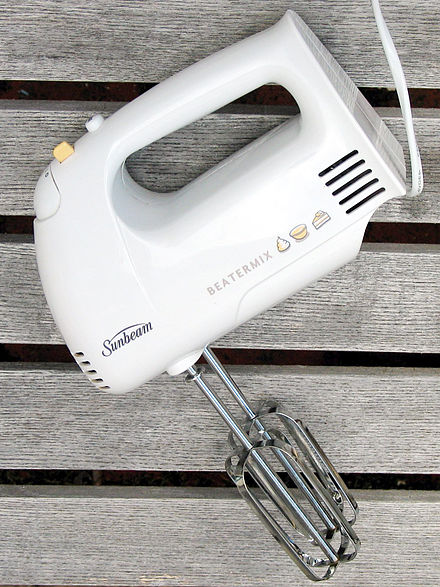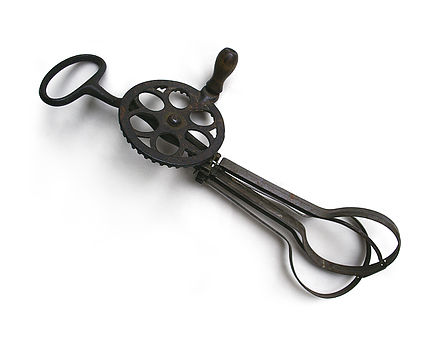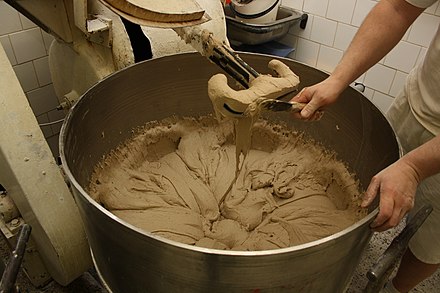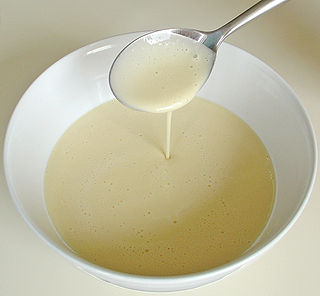
A small appliance, small domestic appliance, or small electrics are portable or semi-portable machines, generally used on table-tops, counter-tops, or other platforms, to accomplish a household task. Examples include microwave ovens, toasters, humidifiers, and coffeemakers. They contrast with major appliances, such as the refrigerator and washing machine, which cannot be easily moved and are generally placed on the floor. Small appliances also contrast with consumer electronics which are for leisure and entertainment rather than purely practical tasks.

A pencil sharpener is a tool for sharpening a pencil's writing point by shaving away its worn surface. Pencil sharpeners may be operated manually or by an electric motor. It is common for many sharpeners to have a casing around them, which can be removed for emptying the pencil shavings debris into a trash bin.

A blender is a kitchen and laboratory appliance used to mix, purée, or emulsify food and other substances. A stationary blender consists of a blender jar with a rotating metal blade at the bottom, powered by an electric motor in the base. Some powerful models can also crush ice. The newer immersion blender configuration has a motor on top connected by a shaft to a rotating blade at the bottom, which can be used with any container.

Kitchenware is any tools, utensils, appliances, dishes, and cookware, that can be used in the process of food preparation, cooking or baking, or the serving of food. Kitchenware can also be used to hold or store food before or after preparation.

A bread making machine or bread maker is a home appliance for turning raw ingredients into baked bread. It consists of a bread pan, at the bottom of which are one or more built-in paddles, mounted in the center of a small special-purpose oven. This small oven is usually controlled by a simple built-in computer using settings input via a control panel. Most bread machines have different cycles for different kinds of dough—including white bread, whole grain, European-style, and dough-only. Many also have a timer to allow the bread machine to activate without operator attendance, and some high-end models allow the user to program a custom cycle.
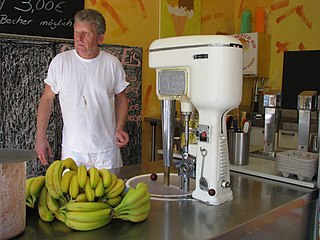
A domestic ice cream maker is a machine used to make small quantities of ice cream for personal consumption. Ice cream makers may prepare the mixture by employing the hand-cranking method or by employing an electric motor. The resulting preparation is often chilled through either pre-cooling the machine or by employing a machine that freezes the mixture.

The Kenwood Chef is a food mixer developed by Ken Wood in Britain. It is a single machine with a number of attachments that allow it to perform many functions. The Chef, based on the earlier A200, was introduced in 1950. Kenwood mixers, along with most other Kenwood products were originally manufactured in the UK by Kenwood Limited. Through globalisation and changes of ownership, eventually production of all products except the Chef and Major mixers were transferred overseas; but even the mixers are all now made in China rather than in Havant. The Chef Mixer was an instant success in the UK and is still Kenwood's top seller today. Kenwood Ltd has been owned by the Italian company De'Longhi since 2001.
An immersion blender, stick blender, wand blender, hand blender, or Bermixer is a kitchen blade grinder used to blend ingredients or purée food in the container in which they are being prepared. The immersion blender was invented in Switzerland by Roger Perrinjaquet, who patented the idea on March 6, 1950. He called the new appliance "bamix", a portmanteau of the French "batere et mixe". Larger immersion blenders for commercial use are sometimes nicknamed boat motors. Uses include puréeing soups and emulsifying sauces.

Feed the Kitty is a Merrie Melodies cartoon directed by Chuck Jones and written by Michael Maltese, in which bulldog Marc Antony adopts Pussyfoot, a kitten, whom he attempts to hide from his owner. The cartoon was released theatrically on February 2, 1952, and in 1994 was voted #36 of the 50 Greatest Cartoons of all time by members of the animation field.

A kitchen scraper is a kitchen implement made of metal, plastics, wood, rubber or silicone rubber. In practice, one type of scraper is often interchanged with another or with a spatula for some of the various uses.
Industrial agitators are machines used in industries that process products in the chemical, food, pharmaceutical and cosmetic industries, in a view of :

Fasnacht Day is an annual Pennsylvania Dutch celebration that falls on Shrove Tuesday, the day before Ash Wednesday. The word translates to "Fasting Night" in English. The tradition is to eat the very best foods, which are part of the German tradition, and lots of it, before the Lenten fast. Fasnachts are doughnuts. There are three types of Fastnachts, one made with yeast, one made with baking powder, and one made with potatoes and yeast. All are slightly crispy on the outside and not as sweet as standard doughnuts.
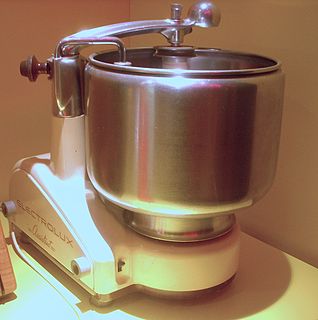
Assistent is a household kitchen appliance, introduced by Electrolux in 1940.
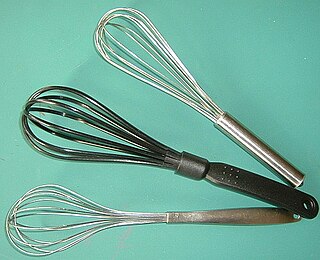
A whisk is a cooking utensil which can be used to blend ingredients smooth or to incorporate air into a mixture, in a process known as whisking or whipping. Most whisks consist of a long, narrow handle with a series of wire loops joined at the end. The wires are usually metal, but some are plastic for use with nonstick cookware. Whisks are also made from bamboo.
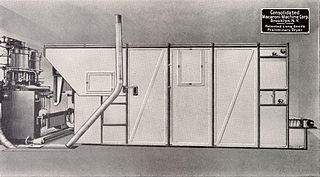
Pasta processing is the process in which wheat semolina or flour is mixed with water and the dough is extruded to a specific shape, dried and packaged.
Anna M. Mangin was an African-American inventor and women's rights campaigner. She invented a kitchen tool she called a pastry fork in 1891. This was different from the eating utensil also known as a pastry fork.
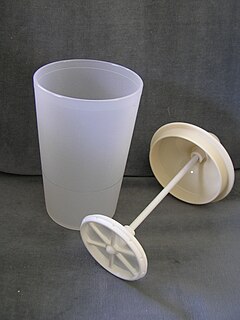
A milk frother is a utensil used for frothing milk, to be added to coffee. Its working mechanism is based on milk aeration. A thick and heavy foam is created by agitating air into the liquid. The tiny bubbles, which are formed during this process, make the milk texture lighter and increase its volume. There are three major types of milk frothers – manual, handheld electric, and automatic. A cappucino machine may have a steam nozzle which can be used to froth the milk. Some devices are able to froth and warm the liquid simultaneously.
